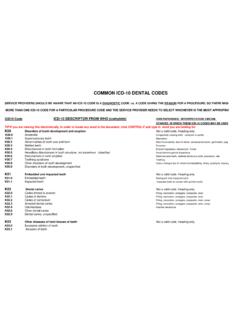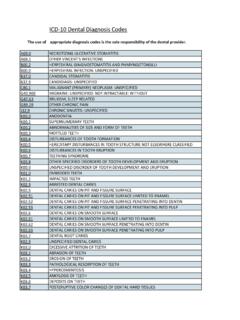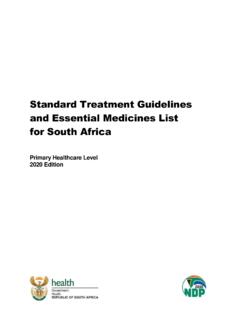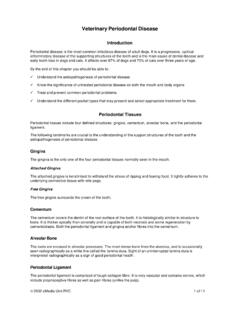Transcription of Annex 1. WHO clinical staging of HIV disease in adults ...
1 Annex 1. WHO clinical staging of HIV disease in adults , adolescents and childrenSource: Adapted from WHO case definitions of HIV for surveillance and revised clinical staging and immunological classification of HIV-related disease in adults and children. Geneva, World Health Organization, 2007 ( ). adults and adolescentsaChildrenClinical stage 1 AsymptomaticPersistent generalized lymphadenopathyAsymptomaticPersistent generalized lymphadenopathyClinical stage 2 Moderate unexplained weight loss (<10% of presumed or measured body weight)Recurrent respiratory tract infections (sinusitis, tonsillitis, otitis media, pharyngitis)Herpes zosterAngular cheilitisRecurrent oral ulcerationPapular pruritic eruptionFungal nail infectionsSeborrhoeic dermatitisUnexplained persistent hepatosplenomegalyRecurrent or chronic upper respiratory tract infections (otitis media, otorrhoea, sinusitis, tonsillitis)
2 Herpes zosterLineal gingival erythemaRecurrent oral ulcerationPapular pruritic eruptionFungal nail infectionsExtensive wart virus infectionExtensive molluscum contagiosumUnexplained persistent parotid enlargementClinical stage 3 Unexplained severe weight loss (>10% of presumed or measured body weight)Unexplained chronic diarrhoea for longer than 1 monthUnexplained persistent fever (intermittent or constant for longer than 1 month)Persistent oral candidiasisOral hairy leukoplakiaPulmonary tuberculosisSevere bacterial infections (such as pneumonia, empyema, pyomyositis, bone or joint infection, meningitis, bacteraemia)Acute necrotizing ulcerative stomatitis, gingivitis or periodontitisUnexplained anaemia (<8 g/dl), neutropaenia (< x 109/l) and/or chronic thrombocytopaenia (<50 x 109/l)Unexplained moderate malnutritionb not adequately responding to standard therapyUnexplained persistent diarrhoea (14 days or more)Unexplained persistent fever (above C, intermittent or constant, for longer than one 1 month)Persistent oral candidiasis (after first 6 weeks of life)Oral hairy leukoplakiaLymph node tuberculosisPulmonary tuberculosisSevere recurrent bacterial pneumoniaAcute necrotizing ulcerative gingivitis or periodontitisUnexplained anaemia (<8 g/dl), neutropaenia (< x 109/l) or chronic thrombocytopaenia (<50 x 109/l)
3 adults and adolescentsaChildrenClinical stage 3 Symptomatic lymphoid interstitial pneumonitisChronic HIV-associated lung disease , including bronchiectasisClinical stage 4cHIV wasting syndromePneumocystis (jirovecii) pneumonia Recurrent severe bacterial pneumoniaChronic herpes simplex infection (orolabial, genital or anorectal of more than 1 month s duration or visceral at any site)Oesophageal candidiasis (or candidiasis of trachea, bronchi or lungs)Extrapulmonary tuberculosisKaposi sarcomaCytomegalovirus infection (retinitis or infection of other organs)Central nervous system toxoplasmosisHIV encephalopathyExtrapulmonary cryptococcosis, including meningitisDisseminated nontuberculous mycobacterial infectionProgressive multifocal leukoencephalopathyChronic cryptosporidiosisChronic isosporiasisDisseminated mycosis (extrapulmonary histoplasmosis, coccidioidomycosis)Lymphoma (cerebral or B-cell non-Hodgkin)Symptomatic HIV-associated nephropathy or cardiomyopathyRecurrent septicaemia (including nontyphoidal Salmonella)Invasive cervical carcinomaAtypical disseminated leishmaniasisUnexplained severe wasting, stunting or severe malnutritiond not responding to standard therapyPneumocystis (jirovecii)
4 PneumoniaRecurrent severe bacterial infections (such as empyema, pyomyositis, bone or joint infection, meningitis, but excluding pneumonia) chronic herpes simplex infection (orolabial or cutaneous of more than 1 month s duration or visceral at any site)Oesophageal candidiasis (or candidiasis of trachea, bronchi or lungs)Extrapulmonary tuberculosisKaposi sarcomaCytomegalovirus infection (retinitis or infection of other organs with onset at age more than 1 month)Central nervous system toxoplasmosis (after the neonatal period)HIV encephalopathyExtrapulmonary cryptococcosis, including meningitisDisseminated nontuberculous mycobacterial infectionProgressive multifocal leukoencephalopathyChronic cryptosporidiosis (with diarrhoea) chronic isosporiasisDisseminated endemic mycosis (extrapulmonary histoplasmosis, coccidioidomycosis, penicilliosis)Cerebral or B-cell non-Hodgkin lymphomaHIV-associated nephropathy or cardiomyopathya In the development of this table, adolescents were defined as 15 years or older.
5 For those aged less than 15 years, the clinical staging for children should be For children younger than 5 years, moderate malnutrition is defined as weight-for-height < 2 z-score or mid-upper arm circumference 115 mm to <125 Some additional specific conditions can be included in regional classifications, such as penicilliosis in Asia, HIV-associated rectovaginal fistula in southern Africa and reactivation of trypanosomiasis in Latin America. d For children younger than 5 years of age, severe wasting is defined as weight-for-height < 3 z-score; stunting is defined as length-for-age/height-for-age < 2 z-score; and severe acute malnutrition is either weight for height < 3 z-score or mid-upper arm circumference <115 mm or the presence of oedema.
















